
The Coati (co-AH-tee) is a relative of the raccoon with a long nose, masked face, and a striped tail. Coatis are curious and energetic, just like kids!
Coati Club News, Fall 2016
Migration: A Long Journey!
Fall is in the air, and so are many animals that are flying south for the winter. Many animals, such as birds, bats, and even butterflies, head south to warmer weather. A large aquatic mammal, the Gray Whale, makes a long journey through ocean waters. This journey is called migration, and the animals that make it are called migrants. Some migrants stay in the Sonoran Desert region. Others pass through on their way south. You’ll get to meet some of these fall migrants along with some fun migration facts in this issue!
Monarch Butterflies:
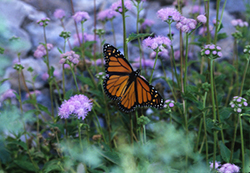
In late summer, Monarch butterflies make an amazing trip each year that lasts about a month. Monarchs from east of the Rocky Mountains group together and migrate south to Mexico from as far north as Minnesota and Canada. Another population, west of the Rocky Mountains, migrates to the California coast. Migrating Monarchs travel about 50 miles a day. They stop along the way to drink sweet flower nectar. This fuels their flight and builds up fat to live off of over the winter. They visit many kinds of flowers but especially depend on milkweed flowers.
Monarchs that migrate to Mexico make their long journey to the oyamel fir forest, nestled on the mountains near the town of El Rosario in the state of Michoacán, Mexico. There, the El Rosario Monarch Sanctuary is prime habitat where millions of butterflies stay for about five months. When they arrive, they cluster upon the fir branches, turning the green boughs orange and black. This habitat provides a cool place where Monarchs slowly burn their stored energy. The surrounding trees protect them from snow and wind. Fog and clouds bring the water they need for moisture.
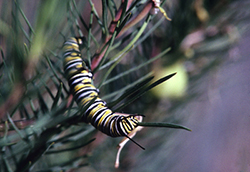
After five months, the butterflies head north again. These butterflies won’t live long enough to make the long journey back to Minnesota. Instead, females lay eggs on milkweed plants along the way. Their young caterpillars eat milkweed leaves until they, too, turn into butterflies. They continue the migration northward as spring moves north, laying their own eggs. In August, the great-great-great grandchildren of the butterflies who spent the winter in Mexico will head south again.
Monarch migration still poses mysteries to scientists. How are they are able to travel so far? Scientists think that Monarchs conserve their “fuel” in flight by gliding on air currents as they travel. They also wonder why these butterflies winter together in groups. They have observed that clusters of Monarchs forming late in the day appear to be tighter on evenings with cooler temperatures. Could this behavior help protect them from the cold, or does it help give an individual Monarch a better chance of escaping if a predator attacks a large cluster?
Closer to home, scientists in Southern Arizona wonder about the Monarchs that pass through the Sonoran Desert region. Are they on their way to spend the winter with the eastern Monarchs in Mexico, or are they headed to California? What questions do you have?
Gray Whales:
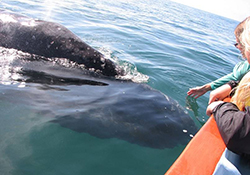
From high in the sky to under the ocean water is another animal that makes an incredible migration – the Gray Whale!
Every year, Gray Whales travel about 12,000 miles – the longest known migration of any mammal. Around October, they swim from cold Arctic Alaskan and Siberian waters, where they have been eating small shrimplike animals and tube worms, preparing for their long migration to winter lagoons off Baja California’s Pacific coast. They arrive there about December and January. These warm, shallow, salty bays are perfect calving grounds and the extra-salty water makes it easier for baby whales to float while nursing, resting, and practicing to becoming good swimmers. By late April or May, the adult Gray Whales, along with the young whales born over the winter, begin the long trip back to the colder northern waters.
Dangers to Animal Migrants:
Both tiny Monarch butterflies and huge Gray Whales face dangers on their yearly migration. Predators, pollution, loss of habitat, and climate change are a few things that can affect or prevent some of these amazing animals from completing their journeys. We can help all animal migrants by making less pollution, protecting their habitat, and, especially for butterflies and birds, planting gardens with native plants to give them food and a place to rest.
What other things can you do to help our migrating animals? Here are a couple of websites you can check out to learn more animal facts and ways you can help!
- Monarch Watch
- http://www.monarchwatch.org/ Look up the Monarch Waystations program for how you can plant resting places and food for migrating Monarchs. The habitat you build will help other animals too!
- Monarch Butterfly/Journey North
- https://www.learner.org/jnorth/monarch/ Follow the Monarch migration with real-time maps made of observations from people just like you.
Amazing Migration Facts!
- Many birds migrate or travel from place to place in different seasons. Sometimes groups of migrating birds are so big, it is possible to see them on radar! The radar screens show them as hazy, cloud-like images. Radar operators sometimes call the fuzzy images “Gatherings of Angels.”
- Swainson’s Hawks spend summers in the plains of western North America. In the fall they migrate to Argentina in South America. By September, their migratory route may take them through the Tucson area! Outside of town, in old farm fields, they gather in groups of as much as a hundred birds. They wait for the morning sun to heat the air and send it rising. Then they lift off into these hot air thermals. They swirl on the thermals in big groups called “kettles” and are on their way. What a sight!
- Like the Monarch butterfly, Rufous hummingbirds are migratory. In the summer they are found in the northwestern U.S., Canada, and southern Alaska. In late summer, they migrate south, spending the winter in Mexico, where it is warmer and flowers continue to bloom. In the spring, they begin their long journey all over again. This is a pretty amazing thing when you think about it - a little bird that weighs about as much as a penny can fly almost 3,000 miles powered by flower nectar and a few insects!
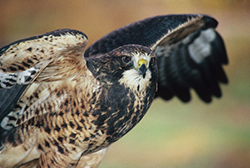
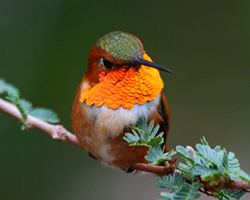
Things to do at Home:
Make a Rufous Hummingbird:
Rufous hummingbirds are known for their reddish brown tones and an occasional flash of bright orange. In certain light, their throat feathers shine and shimmer brightly. This is called iridescence. You can make a shiny Rufous hummingbird. Here’s how!
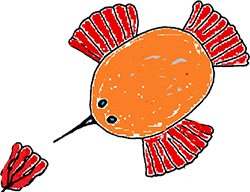
You will need:
- Thin cardboard (like the kind from a cereal or shoe box)
- A reddish orange crayon
- A pointed toothpick
- A black marker
- Aluminum foil
- A paper muffin cup (orange or red is best)
- Construction paper
- Scissors
- Tape
- Glue
Instructions:
- Make the hummingbird’s body by cutting an oval shape out of the cardboard.
- Put aluminum over the oval, covering it. Color over the foil with the reddish orange crayon. The colored foil will look iridescent.
- Cut the muffin cup into four even pieces. Tape one piece on each side of the body to make the wings. For the tail, tape a piece on one end of the body.
- Make a beak by coloring the toothpick with the black marker. Tape it to the underside of the head so it sticks out.
- Cut two small circles of black construction paper to make the eyes. Glue them onto the top of the head.
- Turn the leftover piece of muffin cup into a flower for your hummingbird!
Monarch Butterfly Word Puzzle:
Can Monarchs fly when it rains? Print out this puzzle, use the code chart to decode the words, and find out!
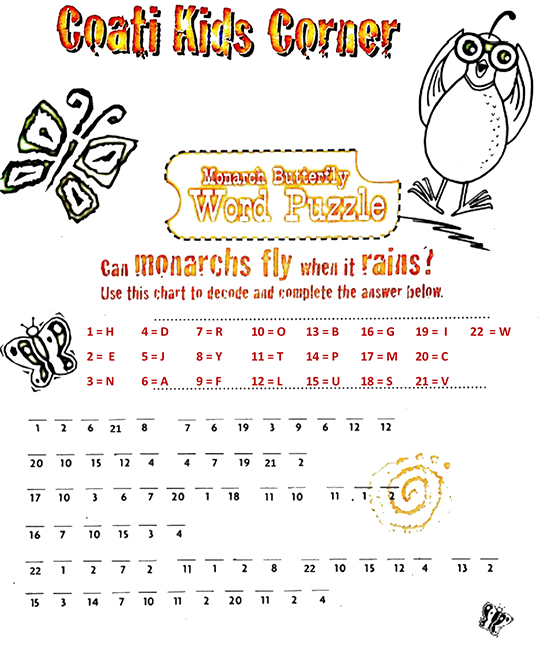
Answer:
Heavy rainfall could drive Monarchs to the ground where they would be unprotected.
Migration Research:
We have talked a lot about migration in this issue of Coati Club News. Choose an animal that migrates into or out of the desert. Here is a list of some you might choose from:
- Phainopepla
- Great Blue Heron
- Lesser Long-nosed Bat
- Mexican Free-tailed Bat
- Turkey Vulture
- Black Vulture
- Lesser Nighthawk
- White Winged Dove
Do a little research on this animal to find out the following questions:
- Where does the animal spend the winter?
- Where does it spend the summer?
- Where does it have its babies?
- What does it eat?
- Is this animal in danger of losing habitat or food sources, and what can be done to help?
Add any other interesting facts you find. Draw a picture of your animal and write or record your answers to these questions to complete your migration research. Then share what you have learned with friends and family!
Photo credits: Swainson's Hawk, Monarch Butterfly, and Caterpillar, Jim Honcoop; Rufous Hummingbird, Don and Shea Sorenson; Gray Whale, Julie Xelowski-Brooker

